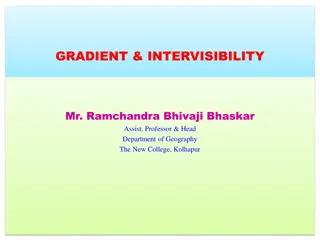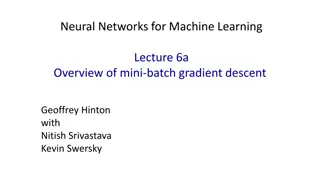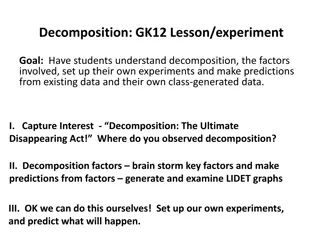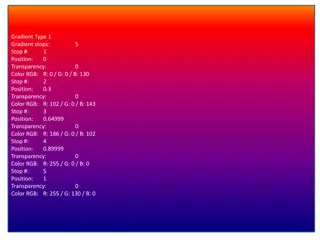Understanding Singular Value Decomposition and the Conjugate Gradient Method
Singular Value Decomposition (SVD) is a powerful method that decomposes a matrix into orthogonal matrices and diagonal matrices. It helps in understanding the range, rank, nullity, and goal of matrix transformations. The method involves decomposing a matrix into basis vectors that span its range, identifying singular values on the diagonal matrix, and finding an orthonormal basis for the nullspace. By utilizing SVD, we can analyze and solve equations efficiently using the conjugate gradient method.
Download Presentation

Please find below an Image/Link to download the presentation.
The content on the website is provided AS IS for your information and personal use only. It may not be sold, licensed, or shared on other websites without obtaining consent from the author. Download presentation by click this link. If you encounter any issues during the download, it is possible that the publisher has removed the file from their server.
E N D
Presentation Transcript
Singular Value Decomposition and the Conjugate Gradient Method CSE 5400 Joy Moore
Range We have the equation Ax=b o A is a M N matrix o x is a N 1 column vector o b is a M 1 column vector A maps N-dimensional vector space onto M-dimensional vector space. But the output of this mapping might not cover all M dimensions o Might be able to reach only a lesser dimensional subspace of the full M- dimensional one o That subspace is called the range
Rank Dimension of the range is the rank rank=number of linearly independent columns If A 0, rank(A) is at least 1 and at most min(M,N) If the M M martix A is nonsingular, the rank is at is maximum value.
Nullity There might exist some nonzero vectors x such that Ax=0 The space spanned by these x s is called the nullspace o the dimension of the nullspace is called the nullity nullity + rank = number of columns N If the M M martix A is nonsingular, the nullity is 0.
Goal of SVD decompose M N matrix A into an M N column- orthogonal matrix U, an N N diagonal matrix W with non-negative elements, and the transpose of an N N orthogonal matrix V: A=UWVT
Columns of U Orthonormal set of basis vectors that span the range Any element in the range can be written as a linear combination of U s columns. If the constant vector b is in the range of A, then the equation Ax=b has a unique solution x. o If not, we can use the least squares solution
Elements of W elements on the diagonal of W are called singular values. singular values of A are defined to be the square roots of the eigenvalues of It is convention to sort these singular values in descending order. o The smallest possible singular value is 0, as all singular values are non- negative. The columns of V whose same-numbered elements are zero are an orthonormal basis for the nullspace.
Elements of W (cont) - The ratio of the largest of the to the smallest of the is called the condition number. - matrix is singular if the condition number is infinite, meaning any of the are zero - matrix is ill-conditioned if the condition number is very large wj's wj's wj's
Using SVD to solve systems of linear equations (when A is square) If A is invertible: In singular value decomposition,
The pseudo-inverse Things could go wrong if any of the are zero. If we encounter any zero-valued in the inverse of matrix W, we replace the 1/ with 0, effectively ignoring these diagonal elements. This is called the Moore-Penrose inverse, or the pseudo- inverse. If A is singular, its true inverse doesn t exist, so we use the pseudo-inverse. wj's wj's wj's
SVD when MN M<N o N-M dimensional family of solutions o Use solve on SVD.h to get the shortest solution M>N o No exact solution (overdetermined) o Get least squares solution by using pseudoinverse
Least squares problem Used when Ax=b has no solution
Other uses Constructing an orthonormal basis o The columns of U whose same-numbered elements are nonzero are an orthonormal set of vectors that span the range of A. o Less roundoff error than Gram-Schmidt orthogonalization wj
Conjugate Gradient Method Used for sparse systems (large matrices A where most of the elements are 0) ordinary method for symmetric, positive-definite A. minimum residual algorithm for A that are symmetric but not positive-definite biconjugate method for systems that are neither symmetric nor positive-definite
Ordinary conjugate gradient method Minimizes the function o To find the minimum, set the gradient equal to 0 o Analogous to optimization in calculus This is done using minimizers and search directions o At each stage a quantity is found that minimizes o the initial search direction is in the direction of the gradient o New search directions are A-orthogonal to the previous ones ak o Basically keeps switching directions until it finds the closest solution
algorithm - Initial search direction d is parallel to the gradient - the alphas and betas are scalars that tell how far in the search direction you ll go - the vector r is defined recursively in terms of the search direction - each search direction is A-orthogonal to all the previous ones.
references Press, William H., and William T. Vetterling. Numerical Recipes. Cambridge Univ. Press, 2007. Conjugate Gradient Method. Wikipedia, Wikimedia Foundation, 21 May 2019, https://en.wikipedia.org/wiki/Conjugate_gradient_method . https://www.youtube.com/watch?v=eAYohMUpPMA























